Japan
Wood Products Prices
Dollar Exchange Rates of 10th
Mar
2023
Japan Yen 136.0
Reports From Japan
March disaster remembered
Events were held around Japan to commemorate the 12th
anniversary of the Great East Japan Earthquake and
tsunami. At 2:46 p.m. on March 11, 2011, a magnitude-9.0
quake struck off the coast of Japan sending waves as high
as 10 metres crashing into coastal communities. Over
120,000 homes were destroyed.
As a result of the tsunami the Fukushima Daiichi nuclear
power plant suffered a triple meltdown releasing large
amounts of radioactive substances into the atmosphere.
Hundreds of thousands of people were forced to abandon
their homes. More than 300 square kilometres of land near
the power plant are still classified as uninhabitable.
Although evacuee numbers have steadily declined, as of
November 2022, 31,438 people remain in temporary
accommodations in Tōhoku, Kanto and other regions. The
majority, some 21,000 evacuees, are from Fukushima
Prefecture home to the crippled nuclear power plant.
See:
https://www.nippon.com/en/japan-data/h01600/
Largest pay rises in two decades agreed
Every March major Japanese firms meet with unions for
wage talks and the deal struck by the big companies
influence wages at smaller firms that employ seven out of
10 Japanese workers. The outcome of this year’s
negotiations will influence how soon the BoJ could begin
to raise interest rates. Improved wages are crucial drivers
of domestic demand.
Japan’s big companies have delivered the largest pay rises
in more than two decades which policymakers hope will
lift the economy from its current deflationary mode. The
wage negotiation outcome will also impact how effective
is the Prime Minister “new capitalism” policy that aims to
more widely distribute wealth among households,
something that builders, wood product manufacturers and
importers have been hoping for.
According to the Ministry of Internal Affairs and
Communications, household spending in January fell from
a year earlier and was the third successive monthly
decline. Private consumption is one of Japan’s key
economic drivers accounting for more than half of the
country’s GDP.
Companies prepare for improved demand
Finance Ministry data shows that, for a seventh straight
quarter up to the end of 2022, Japanese companies
increased capital investment. In the final quarter of 2022
there was an almost 8% increase in investment signaling
that companies prepare for the improvement in demand as
covid rules are eased and as wage increases are anticipated
which could drive up demand.
See:
https://www.japantimes.co.jp/news/2023/03/02/business/economy-business/japanese-firms-spending-raised/
‘Real’ wage shock in January
Data show Japanese ‘real’ wages fell by 4.1% from a year
earlier in January, the 10th consecutive month of decline
as inflation continued to outpace gains in wage which,
according to the Japan Times, suggests it is likely that the
Bank of Japan will maintain its easy policy in the short
term.
https://www.japantimes.co.jp/news/2023/03/07/business/economy-business/japan-wages-down-january/
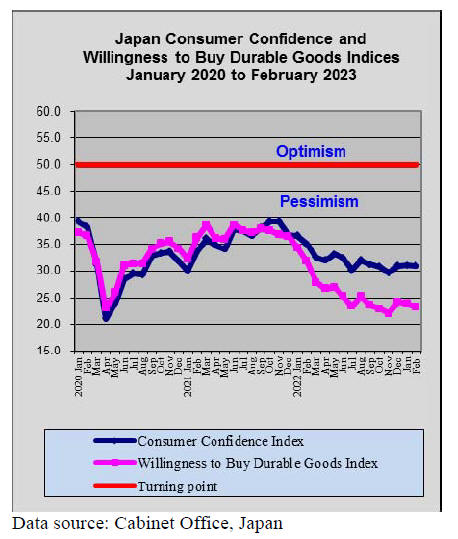
BoJ sticks to past policy, yen steady
In mid-March the yen was trading at almost 137 to the US
dollar. At the latest Bank of Japan policy meeting for the
sitting governor, the decision was to keep interest rates
where they have been pegged since 2016 until there is
evidence that inflation is being driven by wage growth
rather than external factors such as commodity prices.
Wage growth is a key factor in the Bank of Japan’s ultraloose
policy.
See:
https://www.marketpulse.com/20230310/japanese-yenslips-after-boj-maintains-policy-settings-us-nonfarm-payrollsloom/kfisher
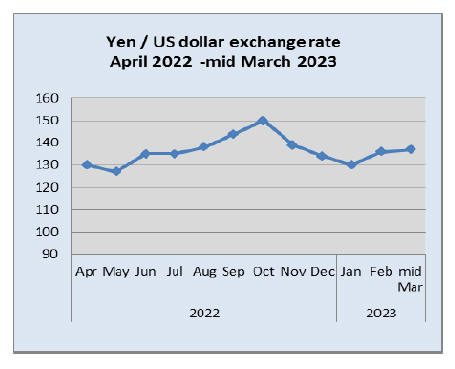
New measures to address unoccupied house
issue
The government has introduced measures aimed at
addressing the issue of unoccupied houses said to run to
around 8 million. The measures allow municipal
governments to promote the use of vacant homes mainly
in city centers and tourist spots through easing regulations
so it is possible to change the use of land plots where
unoccupied houses stand.
The new measures also try to prevent an increase in empty
houses through excluding homes from the current low
fixed asset tax.
See:
https://www.nippon.com/en/news/yjj2023030300152/
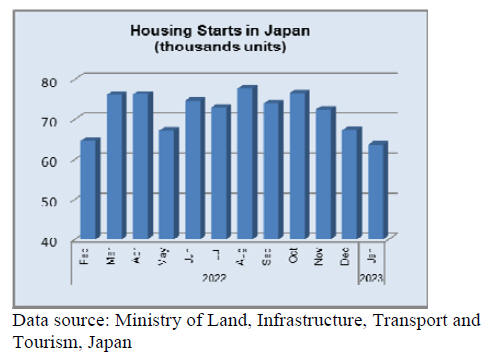
Import update
Assembled wooden flooring imports
After two consecutive months of decline the value of
Japan’s imports of assembled wooden flooring
(HS441871-79) in January almost doubled compared to
the value of December 2022 imports. This jump brings the
value of imports back to the range seen in the second
quarter of 2022.
Year on year the value of January 2023 imports of
assembled wooden flooring was up 23% with China being
the main shipper accouting for 62% of Janaury imports
followed by Malaysia (10%) and Vietnam (7%).
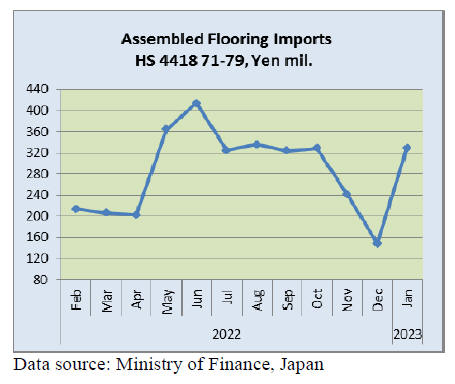
Plywood imports
In the second half of 2022 there was a steady decline in
the volume of plywood imports. Indonesia and Malaysia
are the main sources of Japan’s plywood imports and this
has not changed over the past decade. In 2022 these two
suppliers accounted for over 80% of the volume of Japan’s
plywood imports. For 2023 the Japan Lumber Importers
Association has forecast a 2-3% decline in the volume of
plywood imports.
In January 2023 shipments of plywood from Malaysia and
Indonesia were around 40% below those in January 2022.
There was a decline in shipments from China in January
2023 but shipments from Vietnam rose month on month
and year on year. Compared to the volume of plywood
arrivals in December 2022 there was a 6% decline in
January 2023.
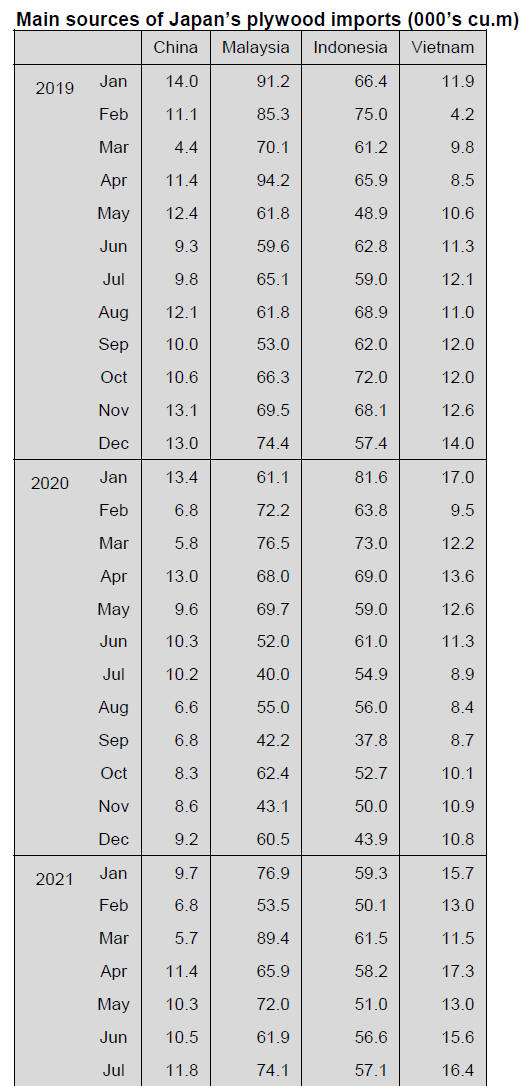 
Trade news from the Japan Lumber Reports (JLR)
The Japan Lumber Reports (JLR), a subscription trade
journal published every two weeks in English, is
generously allowing the ITTO Tropical Timber Market
Report to reproduce news on the Japanese market
precisely as it appears in the JLR.
For the JLR report please see:
https://jfpj.jp/japan_lumber_reports/
Structural laminated lumber import in 2022
Total import of structural laminated lumber in 2022 is
906,288 cbms, 9% more than 2021. This is for the first
time in two years for exceeding 900,000 cbms. However,
the imported structural laminated lumber has been
overstocking since last July in Japan because the total
starts in 2022 declined 4.9% from the previous year’s
starts.
The volume of structural laminated lumber from Finland
increases and it occupies 40% of the total volume. On the
other hand, the volume of Russian structural laminated
lumber decreases 10.3% and of Chinese structural
laminated lumber decreases 12.7% from the previous year.
Violent fluctuations in the volume of imported laminated
lumber occurred in 2022. Monthly average volume is
70,000 cbms but it was 80,000 – 100,000 cbms at the
beginning of 2022 and in the summer season. Then, the
volume declined to 40,000 cbms at the end of 2022.
Comparing the volume of November or December, 2022
against the highest volume in 2022, Estonia and Poland
are 40% down, Finland and Austria are 60% down,
Sweden is 70% down, Romania is 90% down and
Germany is zero.
By size, small is 602,984 cbms, 26.7% up. Medium is
303,110 cbms, 14.7% down. Large is 194 cbms, 59.8%
down. Total import cost is 108 billion yen. This is doubled
import cost from 2021’s import cost and this is 2.5 times
of import cost from 2020’ import cost. One of the reasons
for the increase in 2022 is that the lumber, which were
contracted at 4Q of 2021 arrived to Japan in 2022 due to a
shortage of containers.
A rule for wood business will be mandatory
The Ministry of Agriculture Forestry and Fisheries, The
Ministry of Land, Infrastructure, Transport and Tourism
and The Ministry of Economy, Trade and Industry
consider that ‘Type 1 Wood-related Business’ of the Clean
Wood Act must be mandatory in 2025. ‘Type 1 Woodrelated
Business’ means the business of processing,
exporting selling logs or importing the wood and wood
product.
The Clean Wood Act is also called The Act on Promotion
of Use and Distribution of Legally-harvested Wood and
Wood Products and it went into force on 20th May, 2017.
The Objective of the Clean Wood Act is to promote the
used and distribution of wood and wood products made
from trees harvested in compliance with the laws and
regulations of Japan and the countries of origin.
Plywood
The prices of 3 x 6 12mm thickness of domestic softwood
plywood are 1,900– 1,950 yen, delivered per sheet and of
3 x 6 24mm thickness are 3,800 – 3,900 yen, per sheet.
Many companies start controlling the inventory due to a
term for the settlement of accounts at the end of March.
Also, housing companies and precutting plants request the
plywood companies to lower the prices because the prices
of domestic lumber and laminated lumber have dropped.
A decrease in shipment of plywood is worse than a
decrease in demand of houses. The inventory of plywood
at distribution companies is declining rapidly. Plywood
companies get orders with a few amounts and they are
requested to be prompt delivery. There is enough
inventory to deliver the plywood as soon as the plywood
companies get orders so far.
In Kanto area, there is a price collapse in painted plywood
for concrete form due to the strong yen and a fall in prices
of plywood in South Asia. The prices of 3 x 6 of 12mm
thickness are 2,000 – 2,100 yen, delivered per sheet and
this is 200 yen lower than the prices at the end of 2022.
The purchase cost is 2,200 – 2,300 yen but the Japanese
buyer has bought the plywood by 2,400 yen in the past and
it shows a loss.
Some Japanese buyers sell the plywood at exceptionally
low prices because of a decrease in a futures price in South
Asia and a decrease in the import cost by the strong yen. A
trial calculation of the import cost was 2,600 yen, FOB per
sheet but it was actually 2,400 yen, FOB per sheet, caused
by the strong yen. It does not mean that the prices of
plywood at domestic markets fell 200 yen. The prices in
South Asia are now $750 – 850, C&F per cbm.
|